
The Russian Presidential Press and Information Office, via Wikimedia Commons [CC BY 4.0].
China’s approach towards the Middle East has gone through significant developments in the past decade. Until 2010, China’s engagement in the region was relatively limited and primarily focused on importing oil and gas to satisfy its growing economy. However, since then several factors have led to China’s increased interest in the region. As one of the world’s rising powers, China finds itself in dire need of energy resources and has become the world’s second largest consumer of crude oil.
The Middle East plays an important role in China’s calculations, as the region provides almost half of its oil and natural gas. In addition, the United States’ gradual withdrawal from the region allows China to fill in the void and replace the US as an alternative loan provider and trading partner for the region. The worsening of Sino-American relationship further intensifies China’s desire to increase its footprint and become a major player in the region. Lastly, Xi Jinping’s commitment to the Belt and Road Initiative (BRI) which was launched in 2013, aiming to connect 65 percent of the world’s population, means that China is now increasingly engaging in countries that were regarded previously as the sphere of US influence.
*The opinions expressed in MDC publications are the authors’ alone.








